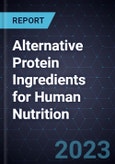A Focus on Sustainable Protein Diversification Will Fuel Growth and Innovation
Alternative protein ingredients are derived from alternative sources such as plants, microbes, and insects or through cell-culture techniques for human nutrition applications. This research service covers the B2B market dynamics of plant protein, microbial protein, and insect protein ingredients for human nutrition applications. The report also covers investment, regulatory, and new product development landscape for other protein ingredients derived from precision fermentation and cell-cultured technologies.
A growing population of vegan, vegetarian, and flexitarian populations will be the key growth drivers, while health and sustainability are the key themes driving consumer choices globally. As consumers’ demand for clean-label products expands, the demand for alternative ingredients that can offer the right texture, flavor, and color profile will witness higher traction.
Plant protein ingredients such as soy, wheat, and peas collectively held the largest share of the total alternative protein ingredients market in 2022, driven by plant-based food and beverage categories, including meat and seafood alternatives, dairy alternatives, and functional snack and beverage products. Novel plant sources such as chickpeas, mung beans, and fava beans are expected to gain higher traction over the forecast period. Across microbial protein ingredients, both filamentous fungi, like mycoprotein and yeast-derived protein ingredients, are expected to witness strong growth given their functional properties.
Application-wise, whilst meat and dairy analogs witnessed a slowdown in demand across some countries between 2021 and 2023, the category will recover, and more niche product categories will drive growth. Formulators need to cater to changing consumer requirements and deliver on the taste, texture, and nutritional profile to drive adoption.
Geographically, North America held the largest share in both volume and value in 2022. The United States is the largest market in the region, driving the bulk of the demand for alternative protein ingredients. Asia-Pacific, Latin America, the Middle East, and Africa will witness the highest growth over the forecast period as the population of vegans and flexitarians in these regions grows.








